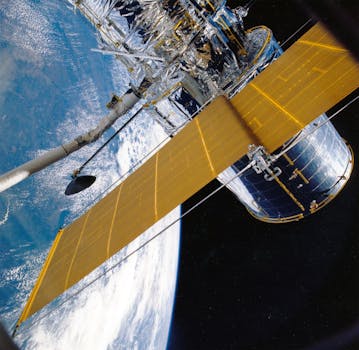GEO Satellites: Understanding the Technology and Applications of Geostationary Earth Orbit Satellites

GEO Satellites: Understanding the Technology and Applications of Geostationary Earth Orbit Satellites
GEO satellites, or geostationary earth orbit satellites, are a type of satellite that orbits the Earth at an altitude of approximately 36,000 kilometers above the equator. These satellites are designed to remain stationary in relation to a fixed point on the Earth’s surface, allowing them to provide continuous coverage of a specific region. GEO satellites are a crucial part of modern telecommunications, navigation, and weather forecasting, and have numerous applications in various fields.
GEO satellites are launched into a geostationary orbit, which is a circular orbit that lies in the equatorial plane of the Earth. This orbit is special because it allows the satellite to maintain a fixed position in the sky, relative to an observer on the Earth’s surface. The satellite’s orbital period is equal to the Earth’s rotational period, which is 24 hours, allowing it to remain stationary above a fixed point on the equator.
History of GEO Satellites
The concept of GEO satellites was first proposed by science fiction writer Arthur C. Clarke in 1945. However, it wasn’t until the 1960s that the first GEO satellite, Syncom 2, was launched. Syncom 2 was a experimental satellite that demonstrated the feasibility of GEO satellites for telecommunications. Since then, numerous GEO satellites have been launched, with applications in telecommunications, navigation, weather forecasting, and more.
The development of GEO satellites has been driven by advances in technology, including the development of more powerful launch vehicles, improved satellite design, and the introduction of new materials and technologies. Today, GEO satellites are an essential part of modern telecommunications, providing services such as television broadcasting, telecommunications, and internet connectivity to millions of people around the world.
Applications of GEO Satellites
GEO satellites have numerous applications in various fields, including telecommunications, navigation, weather forecasting, and more. Some of the most significant applications of GEO satellites include:
Telecommunications: GEO satellites are used to provide telecommunications services such as television broadcasting, telephone services, and internet connectivity. They are particularly useful for providing services to remote or underserved areas, where terrestrial infrastructure is limited or non-existent.
Navigation: GEO satellites are used in navigation systems such as GPS (Global Positioning System) and GLONASS (Global Navigation Satellite System). These systems provide location information and timing signals to receivers on the ground, allowing them to determine their precise location and time.
Weather Forecasting: GEO satellites are used to monitor the weather and climate, providing images and data on cloud patterns, precipitation, and other weather phenomena. This information is used to predict weather patterns and provide early warnings for severe weather events.
Benefits and Challenges of GEO Satellites
GEO satellites offer numerous benefits, including global coverage, high bandwidth, and reliability. However, they also pose some challenges, such as the high cost of launch and operation, interference from other satellites, and the risk of satellite failure. Additionally, the increasing number of GEO satellites in orbit is causing concerns about space debris and the potential for collisions.
Despite these challenges, GEO satellites remain an essential part of modern telecommunications and navigation. They provide critical services to millions of people around the world, and their applications continue to grow and expand into new areas. As technology continues to advance, we can expect to see even more innovative applications of GEO satellites in the future.



